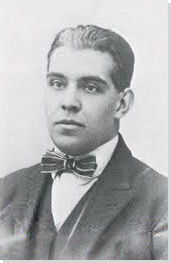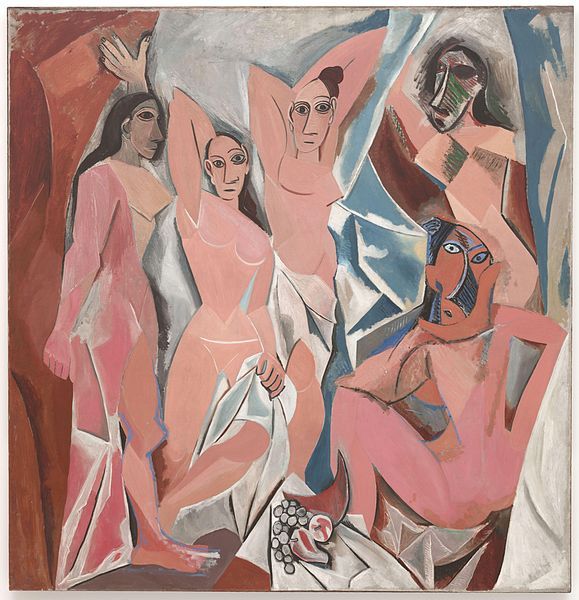Summary of Juan Gris
One of Gertrude Stein's favorite artists, and the only Cubist talented enough to make Picasso uncomfortable, Juan Gris built upon the foundations of early Cubism and steered the movement in new directions. A member of the tight-knit circle of avant-garde artists working in Paris, Gris adopted the radically fragmented picture spaces of Pablo Picasso and Georges Braque, imparting to his works a bold, graphic look. Gris's paintings are immediately distinguishable from theirs, informed by his background as an illustrator, with a slick, almost commercial appearance, and crisp design elements throughout.
Accomplishments
- Whereas Picasso and Braque delighted in destroying the conventions of painting, Gris's chief aim was to please the eye. As the artist himself put it, "I prefer the emotion that corrects the rule". Despite his radical treatment of the picture space, his well-balanced compositions, saturated colors, and traditional subjects popularized the avant-garde movement.
- Like Picasso and Braque, he incorporated newsprint and advertisements into his work. Whereas they tended to snip these elements into smithereens, however, he leaves more of the original pieces of ads and newsprint intact, as if to preserve the integrity of the originals. In lifting popular culture into the realm of high art, he is an important forerunner of Dada and Pop artists, among them Marcel Duchamp, Stuart Davis, and Andy Warhol.
- He was among the visionaries (poets, choreographers, musicians and visual artists) who built pathways among the arts. His costumes for the Ballet Russes show his commitment to interdisciplinary collaboration, an idea that gathered momentum and became central to contemporary art.
Important Art by Juan Gris
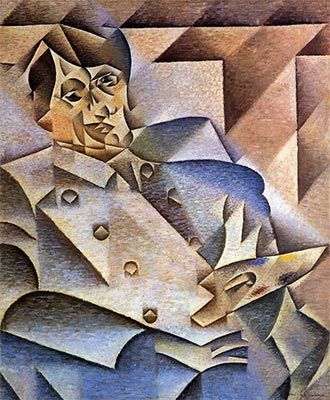
Portrait of Picasso
Gris idolized Picasso. A clever tribute to his mentor, his portrait depicts Picasso (founder of Cubism) in the Cubist style. Palette at the ready, Picasso is literally larger than life (taking up most of the space on the canvas). Working primarily in cool hues of blue, gray, and brown, he fractures the sitter's face into a prism of planes and geometric shapes that resolve into the parallel lines in the background. All parts of this picture seem to be in motion. While he and his fellow practitioners produced many more chaotic images, elements of formal portraiture, such as the legibility of the sitter's features, symmetry of the pose, and high-collared jacket (as opposed to a painter's smock), indicate his respect for the subject. It is entirely in keeping with the Cubist mission, however, in its divergence from traditional representation and effort to capture the dynamism of modern life.
Oil on Canvas - The Art Institute of Chicago
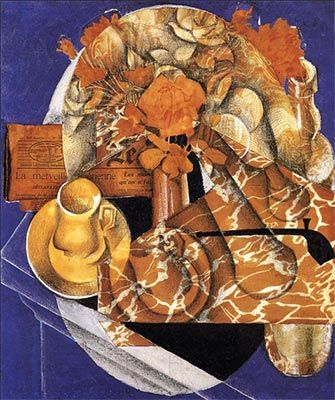
Flowers
Around this time, Gris and other Cubists began incorporating collage elements, such as newspaper and wallpaper, into their paintings. Flowers represents a woman's marble-topped vanity table with a vase of roses, a coffee cup, and the morning paper. A tilting oval mirror reflects wallpaper printed with stylized Art Nouveau orchids. Newspaper and wallpaper (literal scraps of everyday life) force us to consider the subject through the lens of modernity. Gris was particularly fond of rewarding close viewers with hidden messages. Upon close inspection, we glimpse a second coffee cup and pipe camouflaged by the table - evidence that the lady is not alone.
Crayon, Oil, Gouache, Wallpaper, Woven Paper, and Newspaper on Canvas - The Metropolitan Museum of Art, New York
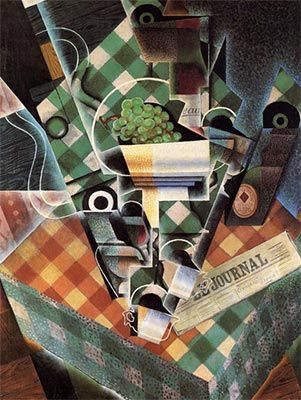
Still Life with Checkered Tablecloth
Think of this painting as the masculine compliment to Flowers. Here, a small bistro table with a checked tablecloth almost overflows with an assortment of objects: a bottle of red wine, bunch of grapes, coffee cups, beer bottle, a stout ceramic pot of preserves, coasters, and a French newspaper. Like Flowers, it too contains a hidden message, this time, in reference to his native Spain: a bull's head. The snout is the coffee cup toward the bottom of the canvas, the ear is the bottle of Bass ale to the right, and the "bull's eye" is the black-and-white coaster to the left. It is a poignant reminder that the artist's homeland remained on his mind, though he would never be able to return there. Flagrantly breaking the rules, and combining "low art" (design elements such as the beer bottle logo and newspaper typography) with "high art" (the traditional still life elements), Still Life with Checkered Tablecloth illustrates his brilliance in furthering the goal of Cubism: making something new out of the connections between life and art.
Oil and Graphite on Canvas - The Metropolitan Museum of Art, New York
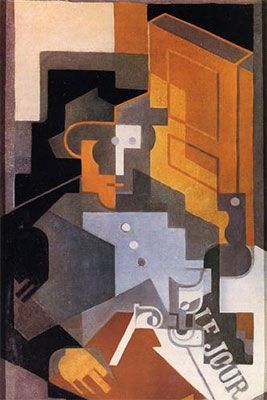
The Man from Touraine
A return to traditional values, subjects, and forms is reflected in Gris's work after 1918, and is typical of avant-garde painting in general in the years after World War I. From summer through fall of 1918, he temporarily relocated to Touraine, the countryside region where his wife, Josette, had grown up, and painted peasants in the traditional clothing of the region. Rather than a specific individual, the old peasant in this scene is an archetypal resident of the area. More somber in tone than many of his preceding works in the Synthetic Cubist mode, and simpler, limited to a figure and some objects arranged in two distinct planes, his representation of a farmer expresses a nostalgic mood and a yearning for an enduring, traditional way of life in a chaotic and uncertain time.
Oil on Canvas - Pompidou Centre, Paris
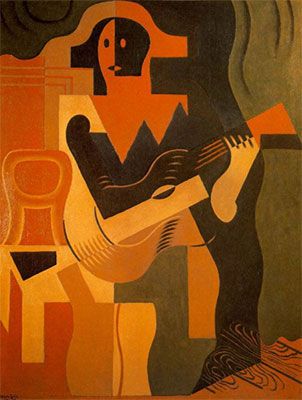
Harlequin with a Guitar
A favorite of Picasso and other modernists who reexamined traditional sources after the war, Harlequin was a stock character in the commedia dell'arte (a form of masked theater that originated in 16th-century Italy) and a trickster figure with a tendency to act on whim and passion. Harlequin, a time-honored subject in art, appears in approximately 40 of his works produced between 1917 and 1925. Here, his background as an illustrator is visible in the cartoonish eyes and mouth, and the bright graphic lines that trace the figure and its costume. Warm color tones and a familiar subject lend the piece a reassuring stability, undermined somewhat by the slippage in details such as the knotholes, which appear to sliding off the table, and the fingers of Harlequin's right hand, which double as the contour of the guitar.
Oil on Panel - The Metropolitan Museum of Art, New York
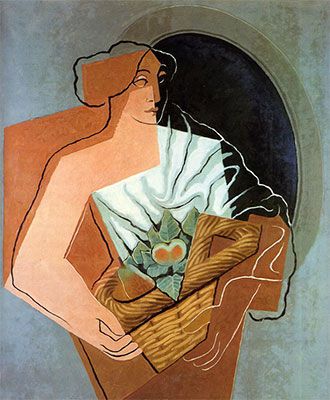
Woman with a Basket
Gris's mysterious painting is of a woman holding a woven basket of vegetables in front of an oval window or mirror. The styling of her hair, face, and clothing recalls Greek and Roman depictions of women, illustrating the renewed interest in classicism and traditional representation of form among European painters after World War I. Like Harlequin and The Man from Touraine, she is a generalized type rather than an individual, perhaps a harvest goddess or an artist's muse. The basket she holds, an element of still-life, recalls his earlier paintings. The hidden message here is less obvious, and yet all the more compelling: the oval behind the figure (either a window or a mirror) is dark, suggesting the approach of death. The piece, one of his strongest and best-known, shows that he remained at the height of his power until the end of his career.
Oil on Canvas - Private Collection
Biography of Juan Gris
Childhood
The man who would become Juan Gris, one of the leading figures in Cubist painting, was born José Victoriano Carmelo Carlos González-Pérez in Madrid in 1887. The thirteenth of fourteen children, he attended Madrid's Escuela de Artes y Manufacturas from 1902 to 1904, where he studied mathematics, physics, and mechanical drawing. Though he was a strong student, the rigidity of academic life did not appeal to him, and his natural ability in drawing encouraged him to shift his focus to the study of art.
Early Training
After leaving school, he studied painting under the tutelage of José Moreno Carbonero, a respected and sucessful artist in Madrid who had himself taught Salvador Dalí and Picasso. It was in 1905, while working under Carbonero, that González-Pérez changed his name to Juan Gris. He sold all his possessions and moved to Paris in 1906, shortly after the death of his father, and would remain in the city for much of his life. However, since he had dodged Spain's obligatory military service, he had no passport and could neither leave France nor return to Spain.
During his early years in Paris, he worked as an illustrator and satirical cartoonist for a variety of magazines and periodicals. He settled in the Montmartre artist commune Bateau Lavoir, where he met Picasso, Braque, Matisse, and the American writer Gertrude Stein, who would become a lifelong admirer and collector of his work. As he developed relationships with fellow artists, he began to devote more energy to his own painting. Following in the footsteps of Picasso and Braque, he initially worked in the style that would be later defined as Analytic Cubism, known for its monochromatic color, use of linear grids, and breaking down of a subject into geometric planes. While he clearly had enormous respect for Picasso, the older man may have been threatened by the younger's talents, or simply annoyed by his flattery, leading Stein to note that, "Juan Gris was the only person whom Picasso wished away."
Despite the lopsided nature of their relationship, his portrait of his mentor attracted the acclaim of fellow artists and critics when it was exhibited at the Salon des Independants in 1912. That same year, he signed a contract that gave the German art dealer Daniel-Henry Kahnweiler (who also worked with Picasso and Braque) the exclusive right to sell his work. After several years of financial difficulties in Paris, the arrangement gave him greater stability and allowed his work to reach a broader and more influential audience.
Mature Period
Though many recognized his talent in its own right, his work followed the austere monochromatic style of Analytic Cubism in the early 1910s, and moved in the direction of Synthetic Cubism - a subsequent phase, distinguished by a broader, bolder use of color and a collage-like approach to composition - from 1914 onward. Departing from Picasso and Braque somewhat, his work from the latter period is distinguished by its move away from shattering abstraction and use of bright, harmonious colors in daring combinations.
As was the case for many artists of the time, the outbreak of World War I threw his personal and professional life into a state of flux. The war disrupted his business relationship with Kahnweiler, though he received financial help from Gertrude Stein. He also spent time with Matisse in his studio at Collioure, in the south of France near the Spanish border. In 1916, he signed a new contract with French art dealer Leonce Rosenberg, another hugely influential collector of modernist art. His work from the early war years examines the interplay between objects and their shadows, and reintroduces complicated planar intersections, sumptuous colors and textures.
Toward the end of the war, he spent several months in Touraine, the native region of his French wife Josette. This period, unique in his art, focuses on depictions of traditional peasant figures, linking him to a broader shift among European artists during and after the war. Increasingly, these artists turned away from the avant-garde disruptions and reinterpretations of form that marked the early 1910s, and instead approached traditional techniques and subject matter with renewed interest that would persist throughout the remainder of his career.
Though he experienced periods of illness and financial strife during the war years, his reputation was steadily rising. He was awarded his first major solo exhibition at Rosenberg's Galerie l'Effort Moderne in Paris in 1919. The following year, he participated in the final major exhibition of Cubist painters at the Salon des Independants.
Late Period
He had been painting prolifically during and after the war, though in 1920 he became ill with pleurisy, a lung inflammation then often confused with tuberculosis. In an attempt to recuperate, he spent the winter at Bandol, on the southeastern coast of France. While there, he spent time with the Russian ballet impresario Sergei Diaghilev, and the two discussed ideas about staging and costumes for upcoming productions. Their conversations eventually yielded a full collaboration, with Gris designing costumes and sets for the Ballet Russes from 1922 to 1924.
Major exhibitions of his work took place at the Galerie Simon in Paris and the Galerie Flechtheim in Berlin in 1923, and at the Galerie Flechtheim in Düsseldorf in 1925. It was during these years that he achieved the peak of popularity and renown that he would know in his lifetime. He was also making his most forceful articulation of his theories on art and aesthetics, delivering his lecture, 'Des possibilites de la peinture' at the Sorbonne in 1924. In it, he describes his belief that a painting was not merely a representation of an object from reality, but something that the artist recreates and reinterprets through his craft.
He was unable to bask in his successes for long, due to ongoing - and worsening - health problems. In 1922, he moved out of central Paris to the suburban area of Boulogne-sur-Seine, in the hopes that a quieter rural atmosphere would ease his chronic asthma. From late 1925 onward, he battled consistent kidney and cardiac ailments. He died in 1927 of kidney failure, leaving behind his wife and young son. He was only 40 years old. In response to Gris's death, Stein wrote a memorial titled The Life and Death of Juan Gris, in which she describes him as "a perfect painter."
The Legacy of Juan Gris
He established himself as one of the most distinctive figures in Cubism during his relatively short life. His paintings combine different viewpoints of a subject in one image, calling attention to the limitations of traditional perspective and striving toward a new way of seeing that reflects the complexity of the modern age. Though primarily associated with painting, Cubism also exerted a profound influence on 20th-century sculpture and architecture. The liberating formal concepts initiated by Cubism also had far-reaching consequences for Surrealism, Dada, and the rise of midcentury Abstract Expressionism. While Picasso and Braque are most often credited with creating the new visual language of Cubism, his distinctive interpretation of the style directly influenced artists such as Salvador Dalí, Joseph Cornell, and Diego Rivera, among many others. In The Secret Life, Dalí writes, "my first cubist paintings... were directly and intentionally influenced by Juan Gris." His incorporation of brand logos and newspaper typography also anticipates the Pop art movement in the years following the Second World War, particularly in the works of artists such as Andy Warhol and Roy Lichtenstein.
Influences and Connections

 Ask The Art Story AI
Ask The Art Story AI